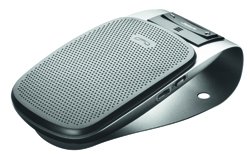 Jabra has been long time friends of DigitalReviews. Back earlier in the year we awarded both the Jabra Freeway and Jabra Stone with our Editor’s Choice Award. We have gotten our hands on the Jabra Drive, the latest car handsfree solution for a *ahem* test drive.
Jabra has been long time friends of DigitalReviews. Back earlier in the year we awarded both the Jabra Freeway and Jabra Stone with our Editor’s Choice Award. We have gotten our hands on the Jabra Drive, the latest car handsfree solution for a *ahem* test drive.
First Impressions
The Jabra Drive is a departure from previous designs in the same genre. It retains the minimalist look and feel, but has a very nice brush metal visor clip rather than the previous thin wire frame. There are only three buttons on this baby – a power button, a rocker switch for volume control and the speaker grill itself acts as an answer/hang up button.
In Action
By default at first start up, the Drive is in pairing mode. It was painless and I was up and running in no time. Each time I get into my car I am impressed with just how fast the connection is made between my phone and the Drive.
The sound quality of the Drive is excellent, I have been on quite a number of conference calls whilst on the road and there has been no complains on the sound quality. With the occasional summer days in Melbourne the sunroof is most certainly open so I can enjoy the sunshine, the noise cancellation works just fine. I have yet to be questioned where I am attending my phone conferences from.
Other Features
The Jabra Drive has Voice Guidance which provides the connection status and battery level (in English only). It can also transmit music, podcasts and GPS directions over Bluetooth. The latter is particularly useful as in the past I have to sacrifice the GPS voice directions for the call functionality.
 Specifications
Specifications
Bluetooth compliance: Bluetooth® 3.0
Security: 56 bit Encryption
Operating range: 10 meters (33 feet)
Paired devices: Up to 8, one at a time
Talk time: Up to 20 hours
Music time: Up to 8 hours
Standby time: Up to 30 days
Charging time: Approximately 2 hours 30 min
Weight: 100 grams (3.38 oz)
Dimensions: folded (off) L104 mm X W56 mm X D18 mm (L 4.09 W 2.20 0.70 D in)
Microphones Directivity: Omni-Directional microphone Sensitivity & Impedance –40 dB +/- 3 dB (1kHz, 0db=1V/Pa); Max 2.2 kΩ
Speaker Size: 36 x 5.7 mm S.P.L 94 db +/-3 dB (0.1 W / 0.1 M) Impedance 4Ω +/- 15% (0.1 W / 0.1 M)
Digital Signal Processing Up to 20 dB noise reduction on transmit signal
Battery Internal rechargeable 1100 mA Li-Polymer battery
Operating temperature Charging 0° C to 45° C (32 F to 113 F); Discharging -10° C to 60° C (14 F to 140 F)
Storage temperature Less than 1 month: -20° C to 45° (-4 F to 113 F); Less than 6 months: C -20° C to 35° C (-4 F to 95 F)
CLA power adapter 12-28 V input; 5 V 750 mA output
Charging plug dimensions Micro-USB
What’s in the package?
* Jabra DRIVE in-car speakerphone
* USB cable
* car charger
* 1 quick start manual
* warranty card
* warning card
Gripes
If I have never used the Jabra Freeway then I would have absolutely no complaints about the Drive. But one feature I would like to have seen included in the Drive is the automatic turn on when I get into the car. The Drive has a 10 minute timeout window where it will turn itself off, and I have to toggle the power switch to turn it back on.
Conclusion
The Jabra Drive is small, simple to use and exceedingly useful. My sun visor thanks Jabra for the new clip design, after a few weeks of being used it has yet to leave an ugly imprint on the plastic. All the features work as advertise and it is now a fixture on my sun visor. And at around AUD$60 it is a perfectly good stocking filler for the festive season, for those who drives around in vehicles without integrated bluetooth (I wouldn’t give up my car for the world … well maybe except for the Turbo X).
DigitalReviews would like to thank Jabra for the on-going support.


